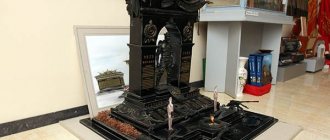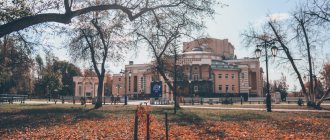Syktyvkar before and after the war
Historians have shown how the city turned from wood to stone
In the 30-50s of the last century, Syktyvkar changed so rapidly that, looking at photographs of those years, it is not so easy to recognize the capital of Komi in them. The participants of the next excursion, organized by the regional branch of the Russian Memorial Society, were convinced of this.
Tickets to the park
The excursion began at the intersection of Kirov and Kommunisticheskaya streets. Nearby, as historian Igor Sazhin reported, there was a trading area in Ust-Sysolsk. It was practically the center of the old city, he lived off this square. Large fairs were held here, which “fed” merchants - not only local ones, but also from the upper reaches of the Vychegda or the Northern Dvina. In addition, there were spiritual centers in the city - Orthodox churches.
Until the early 1930s, the shopping area retained its central status, gradually turning into a park. It was along it that the first Soviet parades took place, and nearby, on a small hill, there was a summer cinema. In those years, cinemas and cultural centers became the spiritual centers of the city. And since the Soviet government did not envision a market economy, trade faded into the background. Cultural pastime came to the fore. And the park played an important role in this.
Entrance to Kirov Park, 1930s.
However, a photograph from the 1930s shows that the park is surrounded by a high fence. It was not so easy to get into it. Moreover, for some time people were allowed into the park with tickets, and they even had their own guard. The entrance to it was constantly changing. But, as can be seen from the photograph, it was always towering and decorated with sculptures and a flag.
And in another photo you can see horses carrying hay. This suggests that the city in the 30s and 40s remained wooden and private. Everyone had cows, whole herds roamed freely around the city. That is, the population continued to feed itself.
Soviet demonstrations in the 30s-50s
Just before the war, a massive building of the Republican NKVD was erected on Kirov Street. Nowadays it is the Ministry of Internal Affairs for Komi, and you can still see a small elevation in front of its porch. And this is no coincidence. Once upon a time, a wooden platform was installed at this place, and October and May Day demonstrations took place in front of it.
“From now on, the NKVD has become the spiritual center of Syktyvkar,” noted Igor Sazhin. “And this is not only the spiritual, but also the economic basis of the region filled with camps.
And in the 50s, demonstrations moved to the equally massive building of the Regional Council of Trade Unions, built in 1951. The tribune was installed on the porch along which the leadership of the city and the republic ascended. This can be clearly seen from the photograph taken on May 1, 1953. So from that time on, trade unions began to play the role of a kind of spiritual center.
At the end of the street on which the Oblsovprof building is located, at the entrance to the park there was a monument to the pilot Mikhail Babushkin. Since 1940, the street itself began to bear his name. Decades later, this monument was moved closer to the Rodina cinema.
Its own VDNKh
Kirov Park is significant in that the Exhibition of Achievements of the National Economy (VDNKh) of the republic was twice held on its territory. The first time it was held for the 15th anniversary of the formation of the Komi Autonomous Region. Ten years later it was repeated on a much larger scale.
“What’s shocking is that it was opened on August 22, 1946, right after the war,” said the historian. “The card system was still in operation, and a huge building was erected for the exhibition.
True, the building itself was wooden, but covered with plaster and quite long - from the entrance to the park from Ordzhonikidze Street to the current stadium. Many exhibits of the Komi National Museum, for example, a tractor, were then located at the Komi VDNKh.
Subsequently, Komi VDNKh was renamed simply “Museum”. A local history museum was located in the nearby former house of the Sukhanov merchants. People first came here, got acquainted with the past, and then went to the museum at the entrance to the park and saw how the Komi region lives today. It was a single complex.
At the end of the 60s, the dilapidated building of the now former Komi VDNH was dismantled.
Museum on the site of Komi VDNKh.
The first hotel and tower
In 1938, at the intersection of Ordzhonikidze and Sovetskaya streets, the city’s first hotel, called “North,” was built. It was made of stone, but with wooden ceilings. Sovetskaya Street was “dressed” in stone by the 1950s.
By the end of the last century, the wooden floors of the hotel were pretty rotten, and in 1991 the entire building had to be demolished. It was planned to build an entire hotel complex on this site, preserving the historical appearance of the previous building. Construction began, but the money ran out, and the unfinished building was bought by customs. Construction was completed in this century.
The fire tower, located opposite the hotel, acquired its modern appearance with a weather vane and a sharp spire only in 1974. Previously, it played a very practical role - it was used to vigilantly monitor whether there were any fires anywhere. But as soon as the city became stone, the utilitarian need for it disappeared: the entire city could no longer be seen from it. The tower was preserved as a decorative decoration, a kind of symbol of the city. And in 1986, after another restoration, a clock was installed on it, performing every hour the melody of a song about Syktyvkar by Yakov Perepelitsa.
Twin buildings
The current Pushkin gymnasium on Sovetskaya Street was built in 1937. This building is interesting because it was built according to the design of the first female architect in Komi, Feofania Tentyukova. For a long time, secondary school No. 14 was located there, which was named after him on the centenary of Pushkin’s death. And in 1991 it received the status of a gymnasium.
Exactly the same building was erected in 1940 on Kommunisticheskaya Street near the current Eternal Glory memorial. It was supposed to house a school for the deaf and dumb there, but at the beginning of the war the premises were transferred to the base of the USSR Academy of Sciences in the Komi Autonomous Soviet Socialist Republic. Now the presidium of the Komi Scientific Center of the Ural Branch of the Russian Academy of Sciences and a scientific library are located there.
This building has changed over the years. In the 50s of the last century, a third floor was added, and in 1985 it was again reconstructed, and now it is significantly different from its twin on Sovetskaya.
Bird's-eye
The tour ended near the former Rodina cinema. This building in the constructivist style was built in 1940 on the site of the Stefanovsky Church, which belonged to the courtyard of the Holy Trinity Stefanovsky Ulyanovsk Monastery. Then there were unpaved streets, dirt, wooden bridges, and there was no sign “Rodina Cinema.” It appeared only in the 50s.
A block behind the drama theater in the 40s, judging by the photograph taken from a bird's eye view, the city ended. There was nothing behind it - continuous fields, among which stand the lonely buildings of the Pedagogical Institute, the House of Press, and the current Komi Scientific Center.
Subsequently, the city was built up not with private “wooden buildings”, but with large stone houses, gradually acquiring a modern appearance.
Igor BOBRAKOV
Photo by the author and oldsyktyvkar.ru
Temple ship
The tour of Kirul began from the site of the former city cemetery, moved from the city center (now Kirov Park) here in 1783. Mikhail Rogachev spoke about the history of the Holy Ascension Church - the only pre-revolutionary temple standing in this place in Syktyvkar.
— Construction began in 1801. It lasted a long time and ended in 1812. The temple was finally completed by 1822, when it was consecrated. This is the most outskirts church of the city. The temple is an example of early Russian classicism. You can call it a church-ship, because in the form in which it has been preserved, it looks like a caravel. Two churches: winter (small, but heated) and summer (large front and unheated) are located in one building.
Mikhail Rogachev
This pre-revolutionary temple is the only one preserved in Syktyvkar. This happened thanks to the “economics” of the NKVD: they set up workshops and a garage here. The bell tower was demolished and was not completely restored after the revolution - it interfered with the landing of planes. But the temple was raised in rank. Before the revolution, it was without a parish, it did not have its own clergy, it was assigned to the city Trinity Cathedral, and the liturgy was served only a few times a year. The temple served mainly for funeral services for Ust-Sysolsk residents who were setting off from here on their last journey. The cemetery was not preserved and was partially moved to the place where the old city cemetery is now located.
More details in the video:
Deacon's House
Igor Sazhin began his part of the tour from the deacon’s house on Zavodskaya Street. The architectural feature of the house is that its log masonry goes right under the roof:
“Unfortunately, this is already a dying, crumbling monument. What's great about this house? It shows the peculiarity of Kirul's architecture. In Syktyvkar you will find, perhaps, another such house. There are several of them in Kirula, about six or seven. What's unusual about them? Its peculiarity is in the log masonry. She goes right to the roof. There is practically no attic there [in the house]. This is a very unusual construction system, a local Kirula tradition brought from some village. The roof lies on logs. The most interesting thing is the northern structure, thanks to it the house has not yet collapsed,” said Igor Sazhin.
More details in the video:
House with storage shed
The next object of the excursion was house No. 45 on Zavodskaya Street - a two-story building where shopping arcades used to be located. Its peculiarity, according to Sazhin, is the attached storehouse, thanks to which merchant carts could unload goods directly into the house.
— Kirul is located at the bend of the Sysola River. A lot of houses that were in old Ust-Sysolsk on the shore simultaneously served as trading houses, that is, goods were stored in them. Storage sheds [utility premises, food warehouse] were built right next to the house. In photographs of old Ust-Sysolsk you can see huge storage sheds just standing on the shore, but here the storage shed is attached to the house. There is no other house in the city where the storage shed is preserved as an extension to the house. What's so good about this attached storage shed? This ledge is very good for unloading and loading in order to go down to Sysol and unload onto ships. The most important connection of Ust-Sysolsk with the rest of the world is only one thing - the river. Goods arriving here are unloaded, stored and sent to stores,” Sazhin explained.











